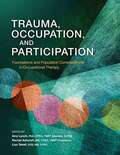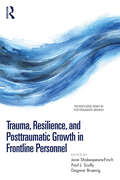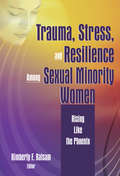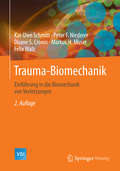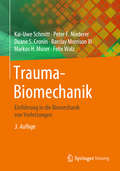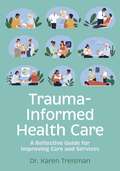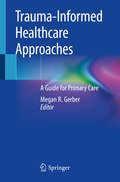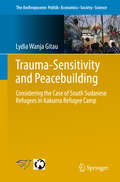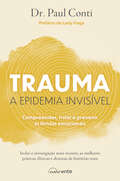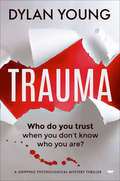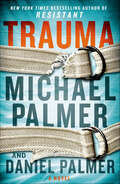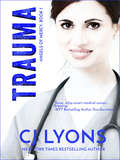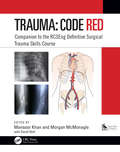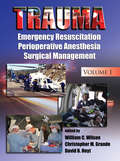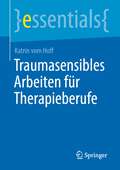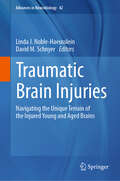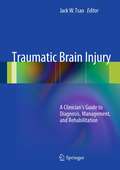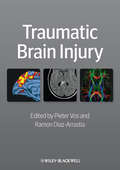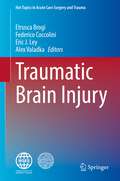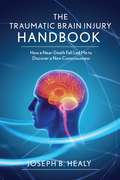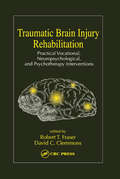- Table View
- List View
Trauma, Occupation, and Participation: Foundations and Population Considerations in Occupational Therapy
by Amy Lynch Rachel Ashcraft Lisa TekellChildren and adults with complex trauma histories need to feel safe, be able to regulate emotions, develop relationships, and gain mastery over their environment and important occupations. Occupational therapy practitioners are valuable members of the complex trauma treatment team because of their expertise in the cognitive, social, emotional, and sensory components of occupation. This comprehensive text guides occupational therapy practitioners in applying trauma-responsive care with their clients across contexts with evidence-based models of assessment and intervention.
Trauma, Resilience, and Posttraumatic Growth in Frontline Personnel (The Routledge Series in Posttraumatic Growth)
by Jane Shakespeare-Finch Paul J. Scully Dagmar BruenigTrauma, Resilience, and Posttraumatic Growth in Frontline Personnel examines the history, context, nature, and complexity of working in front-line services. Chapters provide a detailed overview of specific mental health models that are applicable both on a day-to-day basis and to disaster and major event response. The book also details elements of mental health responses that have been proven to facilitate coping, minimize risk, and promote both resilience and posttraumatic growth. These strategies include, but are not limited to, peer support programs, mental health education, and psychological first aid. Each chapter incorporates research on PTSD, anxiety, and depression as well as research relating to posttraumatic growth, resilience, connectedness, and belongingness. Trauma, Resilience, and Posttraumatic Growth in Frontline Personnel is a vital guide for those who provide care to trauma survivors as well as for researchers and scholars.
Trauma, Stress, and Resilience Among Sexual Minority Women: Rising Like the Phoenix
by Kimberly BalsamPrevent victimization of sexual minority women by raising your awareness level! Trauma, Stress, and Resilience Among Sexual Minority Women: Rising Like the Phoenix is the first resource to examine trauma, violence, and stress as experienced by lesbian and bisexual women. You&’ll gain a better understanding of the stressors that these women experience, including the cultural/social trauma of living with homophobia and heterosexism as well as the individual traumas of verbal, physical, and sexual abuse. This book contains never-before-seen data that investigates the prevalence, impact, and meaning of traumatic experiences in the lives of sexual minority women. In Trauma, Stress, and Resilience Among Sexual Minority Women, top researchers use direct quotes and case examples to illustrate and personalize the emotional strain these women endure. Furthermore, they address constructive individual and community responses that promote resilience and healing. The information and strategies contained in this book will help sexual minority women, as well as the practitioners who serve them, understand and heal from the impact of individual and cultural trauma. This book will increase your knowledge of: developmental issues facing lesbian and bisexual youths the impact of sexual abuse history on the "coming out" process ethnic/racial differences in trauma among lesbian and bisexual women the prevalence and impact of traumatic experience among HIV+ lesbian and bisexual women the unique stressors facing African-American lesbians-and how they cope organized religion&’s approaches to homosexuality and how this impacts lesbian and bisexual women Trauma, Stress, and Resilience Among Sexual Minority Women also shows how data on same-sex domestic violence and hate crimes can be gathered and used as a tool for social and political advocacy, bringing about positive changes that can improve the lives of many lesbian and bisexual women. This book is insightful reading for mental health, health, and social service professionals working with lesbian and bisexual clients or patients, and activists and individuals who work for organizations that serve the gay/lesbian/bisexual/transgender communities.
Trauma-Biomechanik: Einführung in die Biomechanik von Verletzungen (VDI-Buch)
by Kai-Uwe Schmitt Peter F. Niederer Duane S. Cronin Markus H. Muser Felix WalzTrauma-Biomechanik untersucht die Reaktion und Toleranz des menschlichen Körpers auf mechanische Belastungen, die zu Verletzungen führen können. Dabei ist das Verständnis der mechanischen Faktoren, die einen Einfluss auf die Funktionsfähigkeit und die Struktur des Gewebes haben, entscheidend, um Gegenmaßnahmen zur Minderung oder Verhinderung von Verletzungen zu entwickeln.Die Trauma-Biomechanik deckt ein weites Spektrum an Fragestellungen bezüglich Verletzungen ab; namentlich die Klassifikation von Verletzungen, die Verletzungs-Mechanismen und die bekannten Verletzungs-Kriterien. Dieses Buch stellt diese biomechanischen Grundlagen und deren Anwendungen dar. Es behandelt Verletzungen, die im Strassenverkehr und Sport erlitten werden, und geht zudem auf Verletzungen ein, die durch den Einfluss hoher Energien entstehen. Das Buch bietet eine kompakte Darstellung von der Anatomie bis zu ingenieurwissenschaftlichen Ansätzen zur Verletzungsprävention. Dabei wird der in diesem Fachgebiet zweckmässige interdisziplinäre Ansatz verdeutlicht.
Trauma-Biomechanik: Einführung in die Biomechanik von Verletzungen (Vdi-buch Ser.)
by Kai-Uwe Schmitt Peter F. Niederer Duane S. Cronin Markus H. Muser Felix Walz Barclay Morrison IIITrauma-Biomechanik untersucht die Reaktion und Toleranz des menschlichen Körpers auf mechanische Belastungen, die zu Verletzungen führen können. Das Verständnis der mechanischen Faktoren ist entscheidend, um Maßnahmen zur Prävention von Verletzungen zu entwickeln.Dieses Buch stellt die biomechanischen Grundlagen und deren Anwendungen dar. Neben Verletzungen, die im Straßenverkehr und Sport erlitten werden, wird auf ballistische Traumata und Verletzungen durch Explosionen sowie auf Schädigungen durch chronische Belastungen eingegangen. Das Buch bietet eine kompakte Einführung in das Fachgebiet – von zellulärer Biomechanik bis zu ingenieurwissenschaftlichen Ansätzen zur Verletzungsprävention.Der Inhalt• Grundlagen der Trauma-Biomechanik• Überblick über verwendete Methoden, einschließlich Computersimulationen und standardisierter Testverfahren• Systematische Diskussion verschiedener Verletzungen, Verletzungsmechanismen, biomechanischer Kenngrößen und Möglichkeiten der Prävention• Verletzungen durch chronische mechanische Belastung• Aspekte der zellulären Trauma-Biomechanik• Übersicht zur Ballistik und Verletzungen durch Schüsse und ExplosionenDie Zielgruppen• Studierende der Ingenieurwissenschaften, der Gesundheitswissenschaften, der Sportwissenschaften, der Medizin, der biomedizinischen Technik und verwandter Bereiche• Ingenieure, z.B. der Automobil-Industrie• Juristen, Mitarbeitende von Versicherungen und der Unfallforschung
Trauma-Focused CBT for Children and Adolescents: Treatment Applications
by Judith Cohen Anthony P. MannarinoFeaturing a wealth of clinical examples, this book facilitates implementation of trauma-focused cognitive-behavioral therapy (TF-CBT) in a range of contexts. It demonstrates how assessment strategies and treatment components can be tailored to optimally serve clients' needs while maintaining overall fidelity to the TF-CBT model. Coverage includes ways to overcome barriers to implementation in residential settings, foster placements, and low-resource countries. Contributors also describe how to use play to creatively engage kids of different ages, and present TF-CBT applications for adolescents with complex trauma, children with developmental challenges, military families struggling with the stresses of deployment, and Latino and Native American children. Also see Cohen et al.'s authoritative TF-CBT manual, Treating Trauma and Traumatic Grief in Children and Adolescents.
Trauma-Informed Health Care: A Reflective Guide for Improving Care and Services
by Dr. Karen TreismanThis comprehensive reflective resource explores the values, principles and practical applications of trauma-informed and -infused health care. Trauma-Informed Health Care introduces the different types of trauma - including medical and health trauma - and the impact of adversities, social inequalities and stressors. It explores their effects on health and the body, and on people's relationships with health providers. Key issues addressed include the importance of cultural humility, the effects of secondary and vicarious trauma, burnout and moral injury. It also covers the critical issue of organizational trauma: how to avoid practice which has potential to traumatize or retraumatize, and the role of cultural understanding, language, leadership, staff wellbeing and the physical environment.Drawing substantially on the experiences of people who use services and active practitioners, this book spans diverse settings -- from doctor's surgeries to hospitals and allied health services. It reveals how "every interaction can be an intervention" and provides you with practical examples, graphics and reflective exercises to support you to bring about positive change.
Trauma-Informed Healthcare Approaches: A Guide for Primary Care
by Megan R. GerberInterpersonal trauma is ubiquitous and its impact on health has long been understood. Recently, however, the critical importance of this issue has been magnified in the public eye. A burgeoning literature has demonstrated the impact of traumatic experiences on mental and physical health, and many potential interventions have been proposed. This volume serves as a detailed, practical guide to trauma-informed care. Chapters provide guidance to both healthcare providers and organizations on strategies for adopting, implementing and sustaining principles of trauma-informed care. The first section maps out the scope of the problem and defines specific types of interpersonal trauma. The authors then turn to discussion of adaptations to care for special populations, including sexual and gender minority persons, immigrants, male survivors and Veterans as these groups often require more nuanced approaches. Caring for trauma-exposed patients can place a strain on clinicians, and approaches for fostering resilience and promoting wellness among staff are presented next.Finally, the book covers concrete trauma-informed clinical strategies in adult and pediatric primary care, and women’s health/maternity care settings. Using a case-based approach, the expert authors provide real-world front line examples of the impact trauma-informed clinical approaches have on patients’ quality of life, sense of comfort, and trust. Case examples are discussed along with evidence based approaches that demonstrate improved health outcomes. Written by experts in the field, Trauma-Informed Healthcare Approaches is the definitive resource for improving quality care for patients who have experienced trauma.
Trauma-Informed Reproductive Healthcare
by Angela Lawson Amelia SwansonPatients seeking fertility care may have experienced trauma prior to their fertility journey and often have experienced trauma as part of the fertility process itself. It is important for medical and administrative professionals that are involved in providing care to fertility patients to understand how to deliver care from a trauma-informed perspective. This is particularly important as the medical evaluation and treatment for fertility patients often involves invasive questions and procedures that can be difficult for patients with a history of trauma. While exposure to trauma has an international impact, this book is focused primarily on the research and experiences of reproductive medicine patients in the United States. It begins with a broad overview of trauma-informed care, and then goes on to focus on specific types of traumas that are likely to impact reproductive patients, including reproductive loss, sexual trauma, medical trauma, trauma perpetrated on individuals due to their sexual orientation or gender expression/identity, racial trauma or discrimination, and paramilitary trauma. The final chapters of the book are tailored to medical professionals, healthcare administrators and mental health professionals with recommendations for how to incorporate trauma-informed care for their specific role in the healthcare team. This text highlights how trauma-informed care principles apply to reproductive medicine and how trauma-informed care can support specific patient populations, such as those with a history of sexual trauma, medical trauma, reproductive loss, and patients that have experienced discrimination due to their sexual orientation, gender identity or race. Trauma-Informed Reproductive Healthcare provides specific recommendations and best practices for medical professionals and administrators in transforming their practice to be trauma-informed.
Trauma-sensitivity and Peacebuilding
by Lydia Wanja GitauThis book identifies a gap in peacebuilding theory and practice in terms of sensitivity to trauma and its impact on the survivors of war and other mass violence. The research focuses on the traumatic experiences and perceptions of peace of South Sudanese refugees in Kakuma Refugee Camp in Northwestern Kenya. It further explores the possibilities for peacebuilding identified in these perceptions. A lack of sensitivity to the trauma experienced by the survivors of conflict and mass violence leads to interventions that are at best removed from, and at worst detrimental to the welfare of the survivors. Interventions that take into consideration the complex and multifaceted ways in which the survivors experience and respond to the traumatic events, encourage capacities for resilience in the survivors, engage the creative arts in peacebuilding, and emphasise the centrality of community and relationships, are seen to assist the survivors in recovery from trauma and to facilitate peacebuilding.
Trauma: A Comprehensive Emergency Medicine Approach
by Eric Legome Lee W. ShockleyLegome (emergency medicine, SUNY Downstate Medical School Brooklyn) and Shockley (emergency medicine, U. of Colorado) provide a 42-chapter overview of trauma care from the perspective of emergency medicine, for students and clinicians who care for patients with emergency presentations of traumatic injuries. Emergency medicine specialists from the US cover various aspects of care, including decision making, mechanism of injury, the initial approach, multiple casualties and disaster preparedness, airway, trauma to various body regions, and special considerations like trauma in pregnancy, geriatric trauma, sexual assault, injury prevention, rural trauma care, and pain management. Additional chapters address imaging, anesthesia, fluid and blood component therapy administration, procedures, wound management, universal/standard precautions, and administrative aspects like professionalism, communication and interpersonal issues, research, and nursing. Annotation ©2011 Book News, Inc. , Portland, OR (booknews. com)
Trauma: A Epidemia Invisível
by Paul ContiPrefaciado por Lady Gaga, um livro essencial para compreender, tratar e prevenir todas as feridas emocionais. Partindo da investigação mais recente, das melhores práticas clínicas e de dezenas de histórias reais, este é um livro essencial para perceber a pandemia traumática que vivemos. «Sensatez e paciência prevalecem neste olhar único sobre um assunto amplamente ignorado pela comunidade médica durante anos. É uma leitura obrigatória para profissionais, bem como para quem tenha vivido um trauma ou outro sofrimento psicológico.» Tommy Hilfiger, estilista e empresário «O Dr. Conti é psiquiatra, e alguém que também passou por muita coisa. Isto dá-lhe uma perspetiva única acerca de como as pessoas funcionam e de como os traumas nos modificam, e, especificamente, como o trauma nos leva a pensar e a agir de modo diferente sem que percebamos porquê. O Dr. Conti explica como o trauma interage com a forma como o nosso cérebrotrabalha, e como o trauma é afetado por certos aspetos da sociedade, através de vívidas ilustrações de pessoas reais e das suas vidas. Mas o livro não fica por aí. Fornece também soluções reais — soluções que as pessoas poderão usar para si próprias e para os seus entes queridos,e soluções para ajudar a que o mundo se torne um sítio mais bondoso e seguro.» Kim Kardashian, modelo e empresária «Posso agora dizer com certeza que o Dr. Paul Conti me salvou a vida. Fez com que ela valesse a pena ser vivida. Mas, mais importante, deu-me a capacidade de me redescobrir e de me recuperar.» Lady Gaga, cantora e atriz, in Prefácio «Depois de ler o excelente livro de Paul Conti, percebo agora que o trauma existe em todos nós. Às vezes lembramo-nos dele, mas mesmo quando não conseguimos, ele lembra-se de nós, impedindo-nos de viver as nossas vidas com plenitude. Até que o possamos identificar e clarificar, vivemos com medos, ansiedades e máscaras. O livrode Paul Conti ajuda-nos a identificar o(s) trauma(s) que sofremos nas nossas vidas e a avançar em direção à cura – uma tarefa nada fácil no mundo traumático de hoje.» Carole Bayer Sager, cantora e compositora
Trauma: A Gripping Psychological Mystery Thriller
by Dylan YoungAn amnesiac must learn the truth behind his girlfriend&’s death, but he might not like it, in this psychological thriller by the author of The Silent Girls.Who do you trust, when you don&’t know who you are? Cameron Todd is recovering from a serious brain injury. A trauma suffered the same night his girlfriend Emma plunged to her death from a clifftop. The damage erases all memory of the incident and his life leading up to that moment. Both the police and Emma&’s relatives are hunting for someone to blame and question whether his amnesia is a convenient fabrication. Desperate to understand what happened that fateful day, self-doubt creeps in when Cameron learns his relationship with Emma might not have been picture-perfect. Is he a victim, or the perpetrator? Can he trust his injured brain&’s version of events? Or will unearthing the truth reveal something far more sinister? . . .The perfect read for fans of authors like D.S. Butler and Carol Wyer.
Trauma: A Novel
by Michael Palmer Daniel PalmerA disgraced surgeon gets caught in a puzzling conspiracy in this thriller by the New York Times–bestselling author and his acclaimed suspense novelist son.“Start reading and you won’t stop. A chilling medical thriller.” —Tess GerritsenDr. Carrie Bryant is a much-admired neurosurgical resident at an esteemed Boston hospital. When the relentless pace of her residency leads to a life-shattering error, Carrie loses her confidence—and decides to quit her residency and move back home. Her new life’s purpose: To help her combat-vet brother, Adam, recover from a crippling case of post-traumatic stress disorder.The experimental program at the VA Medical Center promises the possibility of curing the ravages of PTSD forever. It seems like Adam’s best option, but Carrie has her doubts when one of her patients goes missing . . . and then another. Carrie joins local investigative reporter David Hoffman in the hunt for answers. The hospital, however, is determined to keep its secrets at all costs. As Carrie and David descend into a labyrinth of murder and corruption, the price Carrie could pay for asking the wrong questions is her own life . . .“A unique novel that shows the strength of both authors’ work.” —Mystery Scene
Trauma: Angels Of Mercy Book 3 (Angels of Mercy Medical Suspense #3)
by CJ LyonsThird in the series that features “tense, whip-smart medical scenes . . . a gripping view of doctors at work” from the New York Times-bestselling author (Tess Gerritsen).Keeping secrets can be murder . . . Angels of Mercy ER charge nurse Nora Halloran has been living with a painful secret for three long years. But when a coworker is brutally assaulted and killed, she knows she can no longer remain silent.Determined to unmask the murderer, Nora teams up with her friends— Lydia, an ER attending with a secret of her own; Gina, the once-cocky resident now struggling to strike a balance between her family and her job; and Amanda, a med student caught between her career and her conscience. As the victim count grows, Nora must face her deepest fears and reveal all her secrets to save the man she loves in order to stop a monster . . . before he returns to silence her forever.(Previously published as Urgent Care)Praise for the Angels of Mercy series“A powerful and dramatic look into the frenzied world of emergency medicine . . . Lyons’ characters are dynamic and genuine.” —Suspense Magazine “A cast of four strong women . . . Un-put-downable pacing with interwoven plot lines. Dr. Lyons writes like a movie filmed without any cuts . . . Pick this book up if: you loved the TV show ER.” —ScienceThrillers.com“Lyons delivers a breathtakingly fast-paced medical thriller.” —Publishers Weekly
Trauma: Companion to the RCSEng Definitive Surgical Trauma Skills Course
by Mansoor Khan, Morgan McMonagle and David M. NottThe Royal College of Surgeons’ of England two-day “definitive surgical trauma skills course” is run by the authors. The course began in 1997 but a new syllabus has recently been put in place.The focus is on thoracic ,abdominal and vascular injuries, caused by both penetrating trauma, such as a knife, and ballistic trauma caused by guns.This Manual accompanies the course and it's aim is to “demystify the body” and show how to control massive blood loss. Interventions, whether they be military or civilian, are descrbed in full, and techniques derived from the battlefield and world-wide hotspots in trauma —are exemplified within this book.
Trauma: Critical Care
by Vladimir I. BakhmutovCompiled by internationally recognized experts in trauma critical care,this sourcediscusses the entire gamut of critical care management of the trauma patient and covers several common complications and conditions treated in surgical intensive care units that are not specifically related to trauma. Utilizing evidence-based guidelines where they ex
Trauma: Emergency Resuscitation, Perioperative Anesthesia, Surgical Management, Volume I
by Martin GardnerProduced by a world-renowned team of trauma specialists, this source reviews initial management considerations beginning in the pre-hospital phase, continues through the primary and secondary surveys of the hospital-based evaluation process, and proceeds to the perioperative management of trauma, burns, and associated conditions. This reference pro
Traumasensibles Arbeiten für Therapieberufe (essentials)
by Katrin vom HoffDieses essential bietet eine fundierte Einführung in die Psychotraumatologie und die traumasensible Arbeit. Anhand von praxisnahen Beispielen traumasensiblen Handelns verfolgt es die Ziele, Unsicherheiten im Umgang mit traumatisierten Patient*innen und Klient*innen abzubauen und Möglichkeiten aufzuzeigen, sich in ihrer Behandlung als wirksam zu erleben. Es stellt dar, wie Fachtherapeut*innen durch ihre traumasensible Haltung und Therapie dazu beitragen können Stabilität, Sicherheit und Selbstwirksamkeit in das Leben von Traumaüberlebenden zu verankern.
Traumatic Brain Injuries: Navigating the Unique Terrain of the Injured Young and Aged Brains (Advances in Neurobiology #42)
by David M. Schnyer Linda J. Noble-HaeussleinThis book focuses on the clinical and preclinical research on traumatic brain injuries where age at time of injury (young versus aged) reveals both parallel and divergent findings at the molecular, cellular, and behavioral levels with insights into alterations in brain structure and function and the implications for recovery. The authors address the hurdles that have been overcome, consider new directions inspired by the most recent research, and the value of data sharing and evidenced based-practice. Traumatic Brain Injuries: Tackling the Unique Terrain of the Injured Young and Aged Brain explores the challenges imposed by an injury that not only causes tissue damage but disrupts brain development and may incite pathological events in the aging brain. With the proliferation of the research literature in traumatic brain injuries, this is the time for a book that surveys the landscape and assesses where the field is headed and what is needed moving forward.
Traumatic Brain Injury
by Jack W. TsaoTraumatic brain injury (TBI) is a major cause of disability worldwide. Each year 1.7 million new TBIs occur in the United States, and it is also considered a signature injury of the Iraq and Afghanistan conflicts. Despite the relatively high incidence-within both civilian and military populations-the diagnosis and treatment, particularly of mild TBI/concussion, remains an inexact science. Traumatic Brain Injury: A Clinician's Guide to Diagnosis, Management, and Rehabilitation is a concise guide designed for neurologists, primary care, and sports physicians and other medical providers, psychologists and neuropsychologists, and athletic trainers who may evaluate and care for patients with TBI. The book features summaries of the most pertinent areas of diagnosis and therapy, which can be readily accessed by the busy clinician/professional. In addition, the book's treatment algorithms provide a highly practical reference to cutting edge therapies. A superb contribution to the literature, Traumatic Brain Injury: A Clinician's Guide to Diagnosis, Management, and Rehabilitation offers a well-designed, well-written, useful resource for all providers who treat patients with TBI.
Traumatic Brain Injury
by Ramon Diaz-Arrastia Pieter VosTraumatic Brain Injury provides practical, neurological guidance to the diagnosis and management of patients who suffer from traumatic brain injury.Taking a "patient journey" in traumatic brain injury, from prehospital management to the emergency department, into rehabilitation and finally reemergence in the community, it demonstrates how neurologists can facilitate recovery at all points along the way. It provides guidelines and algorithms to help support patients with brain injury within trauma centers, in posttraumatic care following discharge, and with mild traumatic brain injury not requiring immediate hospitalization.From an international team of expert editors and contributors, Traumatic Brain Injury is a valuable resource for neurologists, trainee neurologists, and others working with patients with traumatic brain injury.
Traumatic Brain Injury (Hot Topics in Acute Care Surgery and Trauma)
by Federico Coccolini Eric J. Ley Etrusca Brogi Alex ValadkaIn spite of great improvements in prehospital, critical care, and surgical management, traumatic brain injury is still a leading cause of death and disability resulting in great socioeconomic burden. This book provides a comprehensive and practical perspective of the management of traumatic brain injury, from prehospital setting to discharge. Even more, the book highlights the importance of pathways (Trauma Center and Neurocritical Care Unit) and the central role of the specialized neurocritical care team and neurological critical care units in the practice of neurocritical care. Encouraging a practical, protocol-driven, multidisciplinary approach for both adult and pediatric patients, the authors provide a methodological description of the diagnostic and therapeutic management of patients with traumatic brain injury throughout the patient journey. Neuromonitoring assumes predominant importance, with an increasing role of noninvasive monitoring (near-infrared spectroscopy, Pupillometry, transcranial color Doppler-TCD, transcranial color duplex-TCCD, and optic nerve ultrasound) and neurophysiology (electroencephalography and evoked potentials) for early recognition of complications and rapid assessment of the effectiveness of medical treatment. However, the increasing amount of data increases the complexity of interpreting the collected information. The basic principles of multimodal monitoring and the computer-assisted method are presented to provide an overview of the future direction regarding the integration and interpretation of different data obtained from various techniques.Paying particular attention to prognosis and treatment-limiting decisions, the authors reviewed the critical role of neurorehabilitation and the clinical and bioethical perspective on brain death, organ donation, and communication with the family.
Traumatic Brain Injury Handbook: How a Near-Death Fall Led Me to Discover a New Consciousness
by Joseph HealyNew Consciousness is the ultimate brain injury recovery handbook. Inside, acclaimed writer Joe Healy comprehensively discusses what leads to brain injuries and how to heal from them and manage them during the process. Recovery techniques are lifestyle modifications: nutritional, physical, occupational, and attitude ones. This is an important title for all family and friends of sufferers of brain injuries, doctors, and caretakers. With Healy's guidance, support networks will learn how to lead sufferers on their journey back to "normalcy," working and socializing as the person did before the traumatic event. This unique book is distinctive in its scope, covering the science of the brain, its easy-to-follow nature, its accuracy, and its encouraging you-can-recover, don't just learn to cope and give up attitude. Family, friends of the injured person no longer need to feel alone, discouraged, or overwhelmed. This is a much-needed, hands-on, and extremely valuable volume.
Traumatic Brain Injury Rehabilitation: Practical Vocational, Neuropsychological, and Psychotherapy Interventions
by Robert T. Fraser David C. ClemmonsAddressing the critical issues in community re-entry in a very practical manner, this book is suitable for all members of a community re-entry or brain-injury rehabilitation team. Traumatic Brain Injury Rehabilitation: Practical Vocational, Neuropsychological, and Psychotherapy Interventions provides innovative guidelines for allied health members of the traumatic brain injury rehabilitation team with information to help achieve more successful vocational and psychosocial outcomes. The book provides a very clear overview of critical components of neuropsychological information and the use of this information in vocational planning; examples of functional areas of cognition and neuropsychological assessment; the linkages between cognitive and behavioral impairments; the different categories of assistive technology; psychotherapy and behavioral interventions as well as successful vocational interventions; and, models of work access, including methods of supported employment, the development of a tailored job coaching program, and the specifics of utilizing natural supports. This book is useful to anyone involved in neurorehabilitation, vocational rehabilitation, rehab psychology, neuropsychology, and students in counseling programs or studying medical aspects of disability.
